Friday, December 27, 2013
Single Supply fault Monitor Circuit Diagram

Wednesday, December 25, 2013
Environmentally Friendly Mosquito Repeller
We might mention the well-known Chinese coils – the only thing Chinese about them is undoubtedly their name – which very often drive people away as much as mosquitoes, if not more! Moreover they are nasty things to handle. There are also UV (ultra-violet) ‘electrocutors’ consisting of a blue lamp surrounded by two closely-spaced grilles between which a high voltage is applied. The mosquitoes (and fies and other flying insects) are supposedly attracted by the color of the lamp and as they approach, get electrocuted in contact with the two grilles.
The only thing you have to do is pull out the drawer from time to time and get rid of the mass of dead insects. Even though the effectiveness of these first two products remains questionable, it is less so than the one we’re nonetheless going to describe here. We’re talking about an ultrasonic mosquito repellent.
The principle, as described by its numerous promoters, is as follows. Only the female mosquitoes bite (that at least is an undisputed scientific fact) and they bite when they need to feed, and above all, to feed their eggs. In this situation, they seek to avoid the males whose ‘job’ has already been done, and so they fy away from the frequencies emitted by the males when they are on heat. This is where opinions now diverge.

According to certain publications, the frequency emitted by the male mosquitoes is said to be around 20–25 kHz, and so within the realm of ultrasound. But according to others, it is in the region of 5–7 kHz instead; frequencies that a human ear, even an elderly one, can still hear very well. Rather than spending lots of money (of the order of tens of pounds) buying such a device, which moreover generally have a fixed frequency, we’re suggesting building one yourself so that you can carry out your own research this summer, especially since the circuit proposed is very simple and cheap to build.
As the figure shows, it uses just a single IC, a CMOS type 4047. This very multi-purpose IC can be wired in very many operating modes, including that of the multivibrator or astable used here. The operating frequency is set by the external components C1, R1, and P1; the latter makes it possible to slightly adjust the frequency, given the uncertainty that exists over the most efective value…To best reproduce the high frequencies produced by the generator, the output transducer used is a simple tweeter, but it must be a piezo one.
Such a tweeter behaves in fact much like a capacitor, and so doesn’t overload the CMOS IC outputs that are incapable of supplying a substantial current, as everyone knows who’s ever worked with 400 series CMOS logic. To obtain an output signal of sufficient amplitude while being powered from a single 9 V battery, this tweeter is connected between the 4047’s Q and Q outputs, making it possible to apply complementary (antiphase) signals to the tweeter so it ‘sees’ an alternating voltage of double the supply voltage.
In purely theoretical terms, this quadruples the output power available. In practice, it’s better to regard it as tripling it, but the beneft achieved by doing it this way is nonetheless very real. All that remains is for you to place the project in the middle of the patio table or beside your lounger in order to get a taste of the calm of a summer’s evening without mosquitoes bothering you acoustically or worse, biting. At any rate, that’s what we wish for you…
Elektor Electronics 2008
Tuesday, December 24, 2013
Simple Voltage Multiplier Circuit Diagram

Saturday, December 21, 2013
Simple LED Torch
A common problem with small torches is the short life-span both of the batteries and the bulb. The average incandescent torch, for instance, consumes around 2 Watts. The LED Torch in Fig. 1 consumes just 24 mW, giving it more than 80 times longer service from 4 AA alkaline batteries (that is, up to one months continuous service). Although the torchs light output is modest, it is nonetheless quite sufficient to illuminate a pathway for walking.
Circuit Diagram :

Fig. 1 : Simple LED Torch Circuit Diagram
The LED Torch is based on a 7555 timer running in astable mode (do not use an ordinary 555). A white LED (Maplin order code NR73) produces 400 mcd light output, which, when focussed, can illuminate objects at 30 metres. Try Conrad Electronic for what appears to be a stronger white LED (order code 15 37 45-11). A convex lens with short focal length is placed in front of the LED to focus the beam. If banding occurs at the beams perimeter, use another very short focal length lens directly in front of the LED to smooth the beam.
If a different supply voltage is preferred, the value of resistor R3 is modified as follows:
9V - 470 Ohm
12V - 560 Ohm
See my "Wind-up Torch" feature article in the October 2000 edition of Everyday Practical Electronics for a completely battery-free go-everywhere torch.
Thursday, December 19, 2013
Simple But best Regulator Circuit Diagram

Tuesday, December 17, 2013
Watch Dog For Telephones
This little circuit keeps continuous watch over the telephone lines and sounds an alarm in case of any misuse. In addition it transmits a loud tone through the telephone lines to prevent further misuse. When switch S1 is turned on, the normal (on-hook) telephone line voltage at the output of bridge-rectifier diodes D1 to D4 is approximately 48 volts, which being well above the break-down voltage of zener diode D5, the diode conducts.

As a result transistor T2 gets forward biased. This effectively grounds the base of transistor T1 which is thus cut off and the remaining circuit does not get any power supply. In this state, only a small (negligible) current is taken by the circuit, which will not affect the telephone line condition. However, when handset of any telephone connected to the telephone lines is lifted (off-hook), line voltage suddenly drops to about 10 volts.
As a result, transistor T2 is switched off and transistor T1 gets forward biased via resistor R1. Now, the astable multivibrator built around timer IC1 starts oscillating and the speaker starts sounding. Output of the astable multivibrator is also connected to the base of transistor T1 through capacitor C5. As a result, only a loud (and irritating) tone is heard in the ear-piece of the unauthorized telephone instrument.
This circuit can be constructed on a veroboard using easily available low-cost components and it can be connected to any telephone line without the fear of malfunctioning. No extra power supply is required as it draws power from the telephone line for operation.
Note:
- Please disconnect the gadget when you are yourself using the telephone as it cannot distinguish between authorized and unauthorized operation.
Tuesday, October 8, 2013
Simple Transistor Tester
This is a simple circuit but we hope it will help you a lot and save your valuable time. You do not have to use millimeter to test a transistor if you build this circuit. You can have a 9 volts battery to operate the circuit. No matter if the transistor is NPN or PNP, if the transistor is shorted then no any LED should light. If the transistor is open Both the LED should light.
Now remember when you test a good PNP transistor then LED2 should light.
For NPN good transistor only LED1 should light.
Try to make the circuit on a PCB and put in a small box for its safety. Find a three pin socket and mounted it on the box. When you fix everything, only visible parts from the out side of the box should be the switch and three pins of the socket to test a transistor.
Sunday, October 6, 2013
Suzuki Swift 1997 Electrical Wiring Diagram
 |
| Suzuki Swift 1997 Electrical Wiring Diagram |
Friday, October 4, 2013
Pan Pot
Wednesday, October 2, 2013
USB Powered PIC Programmer

Monday, September 30, 2013
Short Wave Monitor
This receiver not only gives a good indication of the myriad of stations on offer in the short-wave band but is also an excellent tool for monitoring the state of the ionosphere. The circuit actually consists of no more than an RF and an AF amplifier. The high-frequency amplification is carried out by the IF stage of a CA3089. This IC is actually intended for FM receivers, but the FM section is not used here. The internal level detector provides a signal of sufficient strength to drive an audio amplifier directly. An LM386 was selected for this task. This IC can directly drive an 8-Ω loudspeaker or headphones without any difficulty.
The power supply voltage is 9 V. Because of the modest power consumption a 9-V battery is very suitable. In addition, the circuit will work down to a voltage of about 5.5 V, so that the battery life will be extra long. The antenna will require a little experimentation. We obtained reasonable results with a piece of wire 50 cm long. A length of wire in the range of 5 to 15 meters should provide even better results at these frequencies.
Saturday, September 28, 2013
Crossover For Subwoofer
The crossover network is intended for use when an existing audio installation is to be extended by the addition of a subwoofer. Often, this additional loudspeaker is one that has been lying around for some time. If its frequency response extends down far enough, all is well and good, but a filter is then needed to cut off any frequencies above, say, 150 Hz. Often, a subwoofer network is an active filter, but here this would necessitate an additional power supply. The present network is a passive one, designed so that the speaker signal of the existing system can be used as the input signal.
Circuit diagram:
 Crossover Circuit Diagram For Subwoofer
Crossover Circuit Diagram For Subwoofer
Since the bass information is present in both (stereo) loudspeakers, the signal for the sub woofer can simply be tapped from one of them. The network is a 1st order low-pass filter with variable input (P1) and presettable cut-off frequency (P2). The signal from the loudspeaker is applied to terminal ‘LSP’. Voltage divider R1-R2-P1 is designed for use with the output signal of an average output amplifier of around d 50 W. The crossover frequency of the network may be varied between 50 Hz and 160 Hz with P2. The values of R3, P2, and C1, are calculated on the assumption that the subwoofer amplifier to be connected to K1 has a standard input resistance of 47 kΩ.
If this figure is lower, the value of C1 will need to be increased slightly. It is advisable to open the volume of the subwoofer amplifier fully and adjust the sound level with P1. This ensures that the input of the subwoofer amplifier cannot be overloaded or damaged. Make sure that the ground of the loudspeaker signal line is linked to the ground of the subwoofer amplifier. If phase reversal is required, this is best done by reversing the wires to the subwoofer. If notwithstanding the above additional protection is desired at the input of the subwoofer amplifier, this is best effected by ‘overload protection ’ elsewhere in this site.
Author: T. Giesberts Copyright: Elektor Electronics
Thursday, September 26, 2013
Float Charger For NiMH Cells
 Diode D1 protects the circuit against reverse polarity of the power supply and protects the LM317 should the power be disconnected while it is still connected to a charged battery pack. Resistor RCL and transistor Q1 limit the maximum current in the event of a short circuit or the connection of a severely discharged battery pack. LED2 provides an indication of voltage input to the charger. LED1 and the 680O resistor provide the same function for the charger output and also provide a minimum load for the regulator when the battery pack is nearing full charge. This is necessary to keep the regulator output from drifting up and damaging the batteries. The circuit uses an external DC plugpack and is suitable for four NiMH cells rated at 2.5Ah.
Diode D1 protects the circuit against reverse polarity of the power supply and protects the LM317 should the power be disconnected while it is still connected to a charged battery pack. Resistor RCL and transistor Q1 limit the maximum current in the event of a short circuit or the connection of a severely discharged battery pack. LED2 provides an indication of voltage input to the charger. LED1 and the 680O resistor provide the same function for the charger output and also provide a minimum load for the regulator when the battery pack is nearing full charge. This is necessary to keep the regulator output from drifting up and damaging the batteries. The circuit uses an external DC plugpack and is suitable for four NiMH cells rated at 2.5Ah. Table 1 gives alternative values for 1-10 batteries in series at peak charge currents of between 200mA to 600mA. If you are using the specified plug-pack and the TO-220 packaged LM317T, you will need a heatsink rated at 12°C/W or better for any design other than the 200mA single cell charger. A TO-3 packaged device with the correct plug-pack will be OK without a heat-sink for any of the 200mA configurations and up to four cells charging at 400mA.
Table 1 gives alternative values for 1-10 batteries in series at peak charge currents of between 200mA to 600mA. If you are using the specified plug-pack and the TO-220 packaged LM317T, you will need a heatsink rated at 12°C/W or better for any design other than the 200mA single cell charger. A TO-3 packaged device with the correct plug-pack will be OK without a heat-sink for any of the 200mA configurations and up to four cells charging at 400mA.Tuesday, September 24, 2013
Modular Phono Preamplifier
High Quality Moving Magnet Pick-up module, Two-stage Series/Shunt feedback RIAA equalization
Any electronics amateur still in possess of a collection of vinyl recordings and aiming at a high quality reproduction should build this preamp and add it to the Modular Preamplifier chain. This circuit features a very high input overload capability, very low distortion and accurate reproduction of the RIAA equalization curve, thanks to a two-stage op-amp circuitry in which the RIAA equalization network was split in two halves: an input stage (IC1A) wired in a series feedback configuration, implementing the bass-boost part of the RIAA equalization curve and a second stage, implementing the treble-cut part of the curve by means of a second op-amp (IC2A) wired in the shunt feedback configuration.
This module comprises also an independent dual rail power supply identical to that described in the Modular Preamplifier Control Center. As with the other modules of this series, each electronic board can be fitted into a standard enclosure: Hammond extruded aluminum cases are well suited to host the boards of this preamp. In particular, the cases sized 16 x 10.3 x 5.3 cm or 22 x 10.3 x 5.3 cm have a very good look when stacked. See below an example of the possible arrangement of the rear panel of this module.
Circuit diagram :
 Modular Phono Preamplifier Circuit Diagram
Modular Phono Preamplifier Circuit Diagram
Parts:
R1_____________270R 1/4W Resistor
R2_____________100K 1/4W Resistor
R3_____________2K2 1/4W Resistor
R4_____________39K 1/4W Resistor
R5_____________3K9 1/4W Resistor
R6_____________390K 1/4W Resistor
R7_____________33K 1/4W Resistor
R8_____________75K 1/4W Resistor (or two 150K resistors wired in parallel)
R9_____________560R 1/4W Resistor
C1_____________220pF 63V Polystyrene or Ceramic Capacitor
C2_____________1µF 63V Polyester Capacitor
C3_____________47µF 25V Electrolytic Capacitor
C4_____________10nF 63V Polyester Capacitor 5% tolerance or better
C5_____________1nF 63V Polyester Capacitor 5% tolerance or better
C6,C9__________100nF 63V Polyester Capacitors
C7,C10_________22µF 25V Electrolytic Capacitors
C8,C11_________2200µF 25V Electrolytic Capacitors
IC1____________LM833 or NE5532 Low noise Dual Op-amp
IC2____________TL072 Dual BIFET Op-Amp
IC3____________78L15 15V 100mA Positive Regulator IC
IC4____________79L15 15V 100mA Negative Regulator IC
D1,D2_________1N4002 200V 1A Diodes
J1,J2__________RCA audio input sockets
J3_____________Mini DC Power Socket
Notes:
- The circuit diagram shows the Left channel only and the power supply
- Some parts are in common to both channels and must not be doubled. These parts are: IC3, IC4, C6, C7, C8, C9, C10, C11, D1, D2 and J3.
- IC1 and IC2 are dual Op-Amps, therefore the second half of these devices will be used for the Right channel
- This module requires an external 15 - 18V ac (50mA minimum) Power Supply Adaptor.
Technical data:
Sensitivity @ 1KHz: 4.3mV RMS input for 200mV RMS output
Max. input voltage @ 100Hz: 53mV RMS
Max. input voltage @ 1KHz: 212mV RMS
Max. input voltage @ 10KHz: 477mV RMS
Frequency response @ 200mV RMS output: flat from 30Hz to 23KHz; -0.5dB @ 20Hz
Total harmonic distortion @ 1KHz and up to 8.8V RMS output: 0.0028%
Total harmonic distortion @10KHz and up to 4.4V RMS output: 0.008%
Source : www.redcircuits.com
Sunday, September 22, 2013
Steam Whistle
Friday, September 20, 2013
Fuse Box BMW 1992 325i Power Distribution Diagram
Fuse Box BMW 1992 325i Power Distribution Diagram
Fuse Panel Layout Diagram Parts: normal speed relay, horn relay, hhig beam relay, low beam relay, inloader relay, fog light relay.
Thursday, September 12, 2013
Tuesday, September 10, 2013
Simple 500W 12V to 220V Inverter
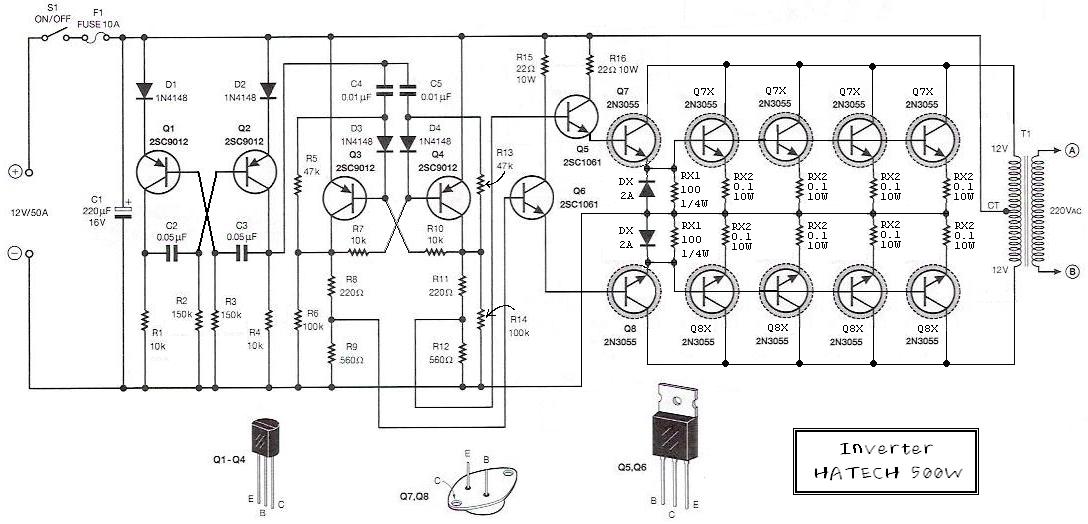
Monday, June 3, 2013
Wiringlight Switch Outlethowishow Answers Search Engine

Is Bright And Switching Lights On When It Is Dull Or Dark Wiring.

Related Topics Light Switch Wiring Switch Wiring Diagram Wiring Switch.

How To Wire A Switch Light Then Switch And Outlet.
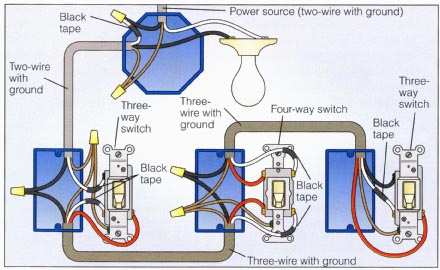
Way Switch Wiring Diagram.

Home Wiring Guide Single Way Lighting Circuit.

Wiring A Light Switch And Outlet Howishow Answers Search Engine.

Wiring A Light Switch Diagram Reviews And Photos.

Rear Fog Light Switch Wiring Nasioc.

Fitting A Double Dimmer Switch Boards Ie.

Light Switch Wiring Diagram.
Tuesday, May 14, 2013
Electronic mosquito repeller

Here is the circuit diagram of an ultrasonic mosquito repeller.The circuit is based on the theory that insects like mosquito can be repelled by using sound frequencies in the ultrasonic (above 20KHz) range.The circuit is nothing but a PLL IC CMOS 4047 wired as an oscillator working at 22KHz.A complementary symmetry amplifier consisting of four transistor is used to amplify the sound.The piezo buzzer converts the output of amplifier to ultrasonic sound that can be heard by the insects.Notes.
* Assemble the circuit on a general purpose PCB.
* The circuit can be powered from 12V DC.
* The buzzer can be any general purpose piezo buzzer.
* The IC1 must be mounted on a holder.
Sunday, May 12, 2013
Nokia Asha 300 Camera Not Working Repair Solution
Sunday, May 5, 2013
JAM Just A Minute Circuit

The circuit given here permits up to eight contestants with each one allotted a distinct number (1 to 8). The display will show the number of the contestant pressing his button before the others. Simultaneously, a buzzer will also sound. Both, the display as well as the buzzer have to be reset manually using a common reset switch. Initially, when reset switch S9 is momentarily pressed and released, all outputs of 74LS373 (IC1) transparent latch go ‘high’ since all the input data lines are returned to Vcc via resistors R1 through R8. All eight outputs of IC1 are connected to inputs of priority encoder 74LS147 (IC2) as well as 8-input NAND gate 74LS30 (IC3). The output of IC3 thus becomes logic 0 which, after inversion by NAND gate N2, is applied to latch-enable pin 11 of IC1. With all input pins of IC2 being logic 1, its BCD output is 0000, which is applied to 7-segment decoder/driver 74LS47 (IC6) after inversion by hex inverter gates inside 74LS04 (IC5). Thus, on reset the display shows 0. When any one of the push-to-on switches—S1 through S8—is pressed, the corresponding output line of IC1 is latched at logic 0 level and the display indicates the number associated with the specific switch. At the same time, output pin 8 of IC3 becomes high, which causes outputs of both gates N1 and N2 to go to logic 0 state. Logic 0 output of gate N2 inhibits IC1, and thus pressing of any other switch S1 through S8 has no effect. Thus, the contestant who presses his switch first, jams the display to show only his number. In the unlikely event of simultaneous pressing (within few nano-seconds difference) of more than one switch, the higher priority number (switch no.) will be displayed. Simultaneously, the logic 0 output of gate N1 drives the buzzer via pnp transistor BC158 (T1). The buzzer as well the display can be reset (to show 0) by momentary pressing of reset switch S9 so that next round may start. Lab Note: The original circuit sent by the author has been modified as it did not jam the display, and a higher number switch (higher priority), even when pressed later, was able to change the displayed number.
Tuesday, April 30, 2013
Build Emergency Light Alarm

Warning! The circuit is connected to 220Vac mains, then some parts in the circuit board are subjected to lethal potential!. Avoid touching the circuit when plugged and enclose it in a plastic box.
Powered by two AA NI-CD batteries
Four switchable options
Circuit diagram
Parts:
R1 220K 1/4W Resistor
R2 470R 1/2W Resistor
R3 390R 1/4W Resistor
R4 1K5 1/4W Resistor
R5 1R 1/4W Resistor
R6 10K 1/4W Resistor
R7 330K 1/4W Resistor
R8 470R 1/4W Resistor
R9 100R 1/4W Resistor
C1 330nF 400V Polyester Capacitor
C2 10µF 63V Electrolytic Capacitor
C3 100nF 63V Polyester Capacitor
C4 10nF 63V Polyester Capacitor
D1-D5 1N4007 1000V 1A Diodes
D6 LED Green (any shape)
D7 1N4148 75V 150mA Diode
Q1,Q3,Q4 BC547 45V 100mA NPN Transistors
Q2,Q5 BC327 45V 800mA PNP Transistors
SW1,SW2 SPST Switches
SW3 SPDT Switch
LP1 2.2V or 2.5V 250-300mA Torch Lamp
SPKR 8 Ohm Loudspeaker
B1 2.5V Battery (two AA NI-CD rechargeable cells wired in series)
PL1 Male Mains plug
Device purpose:
This circuit is permanently plugged into a mains socket and NI-CD batteries are trickle-charged. When a power outage occurs, the lamp automatically illuminates. Instead of illuminating a lamp, an alarm sounder can be chosen. When power supply is restored, the lamp or the alarm is switched-off. A switch provides a "latch-up" function, in order to extend lamp or alarm operation even when power is restored.
Circuit operation:
Mains voltage is reduced to about 12V DC at C2s terminals, by means of the reactance of C1 and the diode bridge (D1-D4). Thus avoids the use of a mains transformer. Trickle-charging current for the battery B1 is provided by the series resistor R3, D5 and the green LED D6 that also monitors the presence of mains supply and correct battery charging. Q2 & Q3 form a self-latching pair that start operating when a power outage occurs. In this case, Q1 biasing becomes positive, so this transistor turns on the self latching pair. If SW3 is set as shown in the circuit diagram, the lamp illuminates via SW2, which is normally closed; if set the other way, a square wave audio frequency generator formed by Q4, Q5 and related components is activated, driving the loudspeaker. If SW1 is left open, when mains supply is restored the lamp or the alarm continue to operate. They can be disabled by opening the main on-off switch SW2. If SW1 is closed, restoration of the mains supply terminates lamp or alarm operation, by applying a positive bias to the Base of Q2.
Notes:
Close SW2 after the circuit is plugged.
This circuit was awarded with publication in ELECTRONICS WORLD "Circuit Ideas", September 2001 issue, page 708.
author: RED Free Circuit Designs
Friday, April 26, 2013
A Handy Pen Torch
This regulated dc provide is used to power two power white LEDs D4 and D6. Resistors R3 and R5 restricts the output present (and hence the light output) of IC1 and IC2 circuits respectively. Besides these parts, one purple colour LED (D2) is integrated in the primary circuit which works as a battery charging provide input indicator. Resistor R1 restricts the operating current of this LED.
Pen Torch Electronic Circuit Schematic

One very simple but dependable ac primarys powered battery charger circuit for the at hand pen torch can also be included here. Basically the pen torch circuit is a continuing current charger wired round Transistor T1 (BC636), energyed by using a 12v/350mA step down transformer and associated elementsD1, D2 and C1.
AC majors powered battery charger for the pen torch

Red LED (D3) provides a set voltage reference to the base of T1, with the assist of resistor R2. (During charging course of, Diode D1 in the primary circuit stop reverse current waft from the battery pack when charging input supply is absent.) After construction of the pen torch circuit, match the assembled unit inside of a small plastic enclosure for security and comfort.
Friday, April 12, 2013
Rear Fog Lamp For Vintage Cars
According to current legislation in many countries, vintage cars must also be fitted with a fog lamp at the rear. In modern cars, there is a bit of circuitry associated with the fog lamp switch to prevent the fog lamp from going on when the lights are switched on if the driver forgot to switch it off after the last patch of fog cleared up. The circuit described here extends that technology back in time. The circuit is built around a dual JK flip-flop (type 4027). T3 acts as an emitter follower, and it only supplies power to the circuit when the lights are switched on.
For safety reasons, the supply voltage is tapped off from the number plate lamp (L2), because it is on even if you accidentally drive with only the parking lights on. The wire that leads to the number plate lamp usually originates at the fuse box. As the states of the outputs of IC1a and IC1b are arbitrary when power is switched on, the reset inputs are briefly set high by the combination of C1, R1 and T1 when the lights are switched on (ignition switch on). That causes both Q outputs (pins 1 and 15) to go low. IC1a and IC1b are wired in toggle mode (J and K high).
The Set inputs are tied to ground (inactive). The driver uses pushbutton switch S1 to generate a clock pulse that causes the outputs of the flip-flops to toggle. The debouncing circuit formed by C2, R4 and T2 is essential for obtaining a clean clock pulse, and thus for reliable operation of the circuit. C1 and C2 should preferably be tantalum capacitors. The Q output of IC1b directly drives LED D1 (a low-current type, and yellow according to the regulations). The Q output of IC1a energises relay Re1 via T4 and thus applies power to the rear fog lamp L1.
Circuit diagram:

Rear Fog Lamp Circuit Diagram For Vintage Cars
Free-wheeling diode D2 protects T4 against inductive voltage spikes that occur when the relay is de-energised. In older-model cars, the charging voltage of the generator or alternator is governed by a mechanical voltage regulator. These regulators are less reliable than the electronic versions used in modern cars. For that reason, a Zener diode voltage-limiter circuit (D3 and R9) is included to keep the voltage at the emitter of T3 below 15 V and thus prevent the 4027 from being destroyed by an excessively high voltage.
The supply voltage for the circuit is tapped off from the fuse box. An accessory terminal is usually present there. Check to make sure it is fed from the ignition switch. The pushbutton switch must be a momentary-contact type (not a latching type). Ensure that the pushbutton and LED have a good ground connection. Fit the LED close to the button.
The following ‘Bosch codes’ are used in the schematic:
- 15 = +12 V from ignition switch
- 58K = number plate lamp
- 86 = relay coil power (+) IN
- 85 = relay coil power OUT
- 30 = relay contact (+) IN
- 87 = relay contact OUT
Author: Eric Vanderseypen - Copyright: Elektor Electronics Magazine
Wednesday, April 10, 2013
Sub Woofer and Controller Rise
all of sub woofers use a immense speaker driver in a immense box, with tuning vents & all the difficulties (& vagaries) that conventional operation entails. By conventional, I mean that the speaker & cabinet are operated as a resonant technique, using the Thistle-Small parameters to get a box which will (if everything works as it ought to) provide excellent performance.

The check methods I used are applicable to any combination, but in general I recommend either a single giant driver or a pair of (say) 300mm units. The next hurdle is the amplifier needed to drive the speaker. This is not trivial. If the selected driver has a sensitivity of 93dB / W @ one metre, then you can safely assume that the efficiency will be less than this below resonance, by a factor of possibly 6dB or more. In case you are used to driving a sub with 100W, this means that you have increased the power to 400W - although this is an over-simplification.
If they are to operate the sub from 60Hz (my aim from the outset), they will increase the power by 12dB for each octave, so if 20W is necessary at 60Hz, then at 30Hz this has increased to 320W, & at 15Hz, you will require over 5kW.
Fortunately, the reality is a tiny different, & 400W or so will be over sufficient for a powerful process, due chiefly to the fact that the energy content in the low bass region is not normally all that great. (Although some program material may have high energy content, in general this is not the case). The EAS process augments the existing process, which is allowed to roll off naturally - contrast this with the normal case, where a crossover is used to separate the low bass from the main process, so existing speaker capability is lost.

The controller is (actually very) simple, & the circuit is shown in Figure one. An input buffer ensures that the input impedance of the source does not affect the integrator performance, & allows summing of left & right channels without any crosstalk. The output provides a phase reversal switch, so that the sub can be properly phased to the remainder of the process. If the mid-bass disappears as you advance the level control, then the phase is wrong, so switch to the opposite position.

The integrators (U1B & U2A) include shelving resistors (R6 & R9), & the capacitor / resistor networks (C1-R4, C3-R7) be positive that signals below 20Hz are attenuated. In case you dont require to go that low, then the worth of the caps (or the resistors R4 & R7) can be reduced. I used four.7uF caps, & these are non-polarized electrolytic - a high value was needed to keep the impedance low to the integrators. I originally included the dual pot (VR1) to permit the upper frequency roll off to be set - however it does no such thing (as described above). The final output level is set with VR2, which may be left out if your power amp has a level control.
The unity gain range (using a 20k pot as shown) is from 53Hz to 159Hz. This ought to be sufficient for most systems, but if desired, the resistors (R5 & R8) can be increased in value to 22k, or you can select a bigger value pot. Using 22k resistors & the 20k pot will give a range from 36Hz to 72Hz.
The input must be a standard full range (or for a stampeded method, the whole low frequency signal). Do not use a crossover or other filter before the EAS controller. For final modification, and to integrate the method in to your listening room, I recommend the constant-Q equalizer. The final result using this is extraordinarily nice - I have flat in-room response to 20Hz!
The EAS method is surprisingly simple to set up with no instrumentation. Of coursework in case you have an SPL meter & oscillator you can also confirm the settings with measurements. Keep in mind that the room acoustics will play havoc with the results, so unless you require to drag the whole method outside, setting by ear might be the simplest. Even in case you did get it exactly right in an anechoic surroundings, this would alter one time it was in your listening room anyway.
It takes a small experimentation to get right, but is surprisingly simple to do. When properly set, a check track (or bass guitar) ought to be smooth from the highest bass note to the lowest, with no gross peaks or dips. Some are inevitable because of room resonances & the like, but you will discover a setting that sounds "right" with small difficulty.
I measured 80dB SPL at one meter in my workshop (sub-woofer perched on a chair in more or less the middle of the space) with at 25Hz & 70W. This improved dramatically when the unit was installed in the listening room, but as I said earlier, there is usually not a lot recorded below around 35Hz. The longest pipe on the organ is usually about 16Hz, but larger pipes still may be used. It was found necessary to cease group of diapasons (able to 8Hz) in the famous Sydney Town Hall organ because when they were used, the very low frequency caused building destroy.


Monday, April 8, 2013
Low Voltage Step Down Converter
The essential advantages are:
- small (but still manually solderable) SMD package;
- high operating frequency (750 kHz) => small external inductor;
- integrated power MOSFETs => high efficiency (up to 95 %);
- no external switching diode necessary.
You can thus use this device to build a very compact, highly efficient voltage converter. A sample layout generated by the author is available as a file on the Elektor website. The TSOP62000 provides an internal reference potential of 0.45 V, which can be used to set the output voltage in the range of 0.5 V to 5 V by means of resistors R2 and R3. The formula for this is: Vout = 0.45 V + (0.45 V) × (R2 / R3) For relatively low voltages, the value of inductor L1 should be 10 µH, but a value of 22 µH is better if the output voltage is 3.3 V or more. The input voltage can be anywhere in the range of 2 V to 5.5 V, and of course it has to be higher than the desired output voltage. The output voltage is 3.3 V with the indicated component values and an input voltage of 5 V. If you want to reduce the component count even further, you can use a member of the family with a fixed output voltage. The available voltages are 0.9, 1.0, 1.2, 1.5, 1.8, 1.9, 2.5, and 3.3 V. With this approach you can omit R2, R3 and C3, so the output can be connected directly to pin 5.
Saturday, April 6, 2013
Trailer Wiring Diagram Connectors Pinoutcircuit Schematic

Trailer Light Wiring Typical Trailer Light Wiring Diagram.

Trailer Wiring Electrical Connections Are Used On Car Boat And.

Typical 7 Way Trailer Wiring Diagram Circuit Schematic.
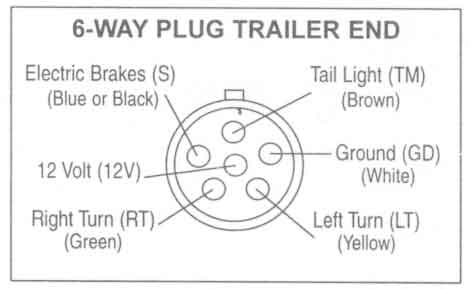
Trailer Wiring Diagrams Johnson Trailer Sales Colfax Wisconsin.

Way Trailer Wiring Diagram And Connectors Pinout Circuit Schematic.

Post It But I Ll Try To Diagram It Here.

Pj Trailers Plug Diagram.
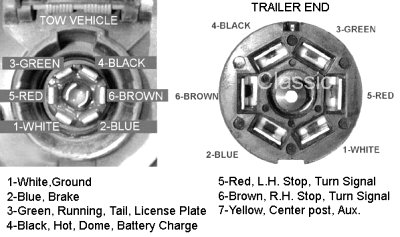
Troubleshooting Trailer Wiring.
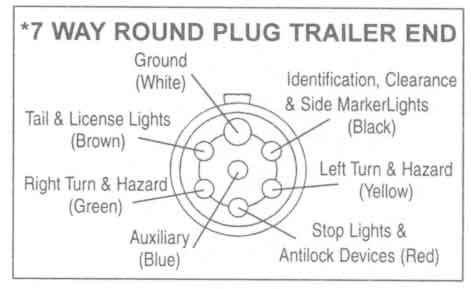
Trailer Wiring Diagrams Johnson Trailer Sales Colfax Wisconsin.

This Allows You To Connect Up The Wiring To Tow A Caravan Or Trailer.


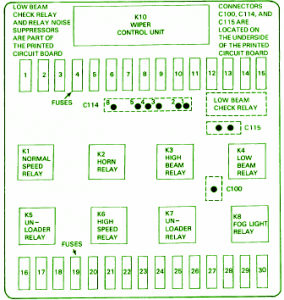
 Lub Oil Filter Arrangements Duplex
Lub Oil Filter Arrangements Duplex